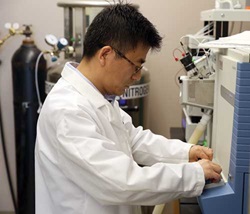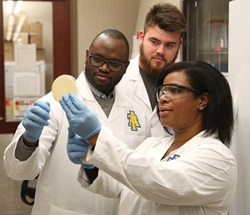North Carolina A&T Elevates the Postharvest Game
INSIDE ACADEMIA
 Plant foods contain many bioactive compounds with properties that have long been recognized as beneficial to human health, inciting a great deal of product development that involves simply adding plant compounds to foods to make them more “functional.” But is that all there is? Not at the Center for Excellence in Post-Harvest Technologies (CEPHT) at North Carolina Agricultural and Technical State University (North Carolina A&T). CEPHT scientists are investigating new technologies that can improve the way vegetables, fruits, and grains are processed, preserved, and developed into products, adding more purpose to functional foods. By ferreting out the complexities of the extraordinary functional properties of various plant compounds, these scientists are creating novel products that are so innovative, they’re patented.
Plant foods contain many bioactive compounds with properties that have long been recognized as beneficial to human health, inciting a great deal of product development that involves simply adding plant compounds to foods to make them more “functional.” But is that all there is? Not at the Center for Excellence in Post-Harvest Technologies (CEPHT) at North Carolina Agricultural and Technical State University (North Carolina A&T). CEPHT scientists are investigating new technologies that can improve the way vegetables, fruits, and grains are processed, preserved, and developed into products, adding more purpose to functional foods. By ferreting out the complexities of the extraordinary functional properties of various plant compounds, these scientists are creating novel products that are so innovative, they’re patented.
 Unraveling the Mysteries of Bioactive Compounds
Unraveling the Mysteries of Bioactive Compounds
At the CEPHT, investigating bioactive plant compounds to create functional foods and natural supplements has been elevated to the precision of studying bioactive compounds to develop pharmaceutical drugs. “Just identifying bioactive compounds is not enough,” says Shengmin Sang, an associate professor in the Department of Family and Consumer Sciences at North Carolina A&T and lead scientist at the CEPHT. “We need to further understand the efficacy, the bioavailability, the biotransformation, and the molecular mechanisms.” He uses bioactive compounds to develop natural products to prevent or treat chronic diseases such as colorectal cancer, metabolic syndrome, diabetes, obesity, and age-related diseases. “For the past five years, we have been studying bioactive compounds in ginger, rosemary, black tea, [and] green tea and in different whole grains, such as whole grain wheat [and] oat.” And while other researchers have studied the potent compounds plants possess, Sang and his laboratory staff have thoroughly analyzed the nuances of these compounds, such as the variation of a single compound depending on which plant food it appears in or how that food is processed. “We believe that different compounds play different roles, and they may have additive and synergistic effects,” Sang explains.
This phenomenon is evident with ginger; the bioactive compounds present in ginger undergo a metamorphosis when the spice is processed. “During the drying process, the chemical composition [of ginger] changes. In fresh ginger, the main component is gingerols,” Sang reveals. “During thermal processing, gingerols are not stable, so as they are dehydrated, they generate another compound called shogaol. So dry ginger contains high levels of shogaol while fresh ginger contains high levels of gingerols.” Both compounds possess a host of properties that are associated with alleviating nausea and other digestive issues and exhibiting cytotoxic activity in cancer cells. However, in studies that Sang has conducted with his research team, he determined that the shogaol compound in dry ginger has much stronger anticancer activity than the gingerol in fresh ginger even though their chemical structures are very similar (because one compound is a derivative of the other). Conversely, after collaborating with a scientist at North Carolina Central University, Sang found that gingerol in fresh ginger is far more effective against anemia than shogaol in dry ginger. “So that means fresh ginger may be good for anemia, but dry ginger may be better for colorectal cancer prevention,” Sang states.
 Aspirin With a Hint of Ginger
Aspirin With a Hint of Ginger
Sang’s experiments with ginger don’t end there. Having studied medicinal chemistry and phytochemical chemistry, he has long been interested in using the potent natural properties of bioactive compounds in plant foods to mask the harmful side effects of medicinal drugs while increasing the efficacy of both types of compounds. For the plant compound, the obvious choice for Sang was ginger, and for the pharmaceutical agent, he looked to a drug that is also a derivative of plants: aspirin. “We thought, why don’t we link aspirin with bioactive food compounds? The rationale behind that is, aspirin is a [miracle] drug. It works for so many things,” Sang proclaims. Originally developed to relieve pain and inflammation, aspirin has since been found to be effective at dissolving blood clots and reducing the risk of heart attacks, stroke, and more recently, colon cancer. “But aspirin has side effects; it causes [gastrointestinal] bleeding—even if you use low-dose aspirin,” Sang points out. “Cardiovascular patients have to take aspirin daily, and to prevent colorectal cancer, people will also have to take it for a really long time. So how do we prevent the side effects of aspirin? Our idea is to link another bioactive compound with aspirin that can prevent aspirin from being released in the upper GI tract.”
Because ginger has the natural ability to prevent or reduce gastrointestinal issues, Sang and his research team have combined ginger compounds with aspirin to produce prodrugs. Prodrugs are compounds that undergo a chemical conversion through a metabolic process to become an active pharmacological agent. In laboratory tests, the aspirin- and ginger-based compounds were more effective at killing colon cancer cells than either component alone. “So you have two active compounds [that] have additive synergistic effect in terms of efficacy,” Sang asserts. “We’ve also linked aspirin with resveratrol, a compound in red wine. … Along this line, we’ve received three patents, and one of our patents was licensed by a pharmaceutical company in Minnesota.” In fact, Sang has developed 10 different compounds combining aspirin and ginger derivatives. “Hopefully we can develop our compound as an aspirin alternative to decrease the side effect of aspirin but increase its efficacy. … We have to pick the top one or two to move forward in clinical studies after we ensure safety and that there is no unexpected toxicity,” Sang reveals. “We expect that after one or two years, we can administer our compounds to humans. I’m working with that [pharmaceutical] company, and we are trying to first synthesize the compound in a [good manufacturing practice] environment.”
 Sang holds several patents for products he has developed alone or with collaborators. Because a number of Sang’s patents involve prodrug products, it may seem that a significant part of his research is drug discovery, but it is not. Sang says that his main focus is finding foods and food compounds that can be effective at fighting disease. “We are mainly focused on dietary approaches for [disease] prevention instead of drugs,” Sang says. “I was trained at a center for drug discovery, so I always keep that in mind. If we can use the combination and it’s effective, why not?” While Sang has been identifying bioactive plant compounds, determining their potency and effectiveness against ailments, and combining them with other compounds to increase their bioavailability, another member of the CEPHT research team has been concentrating on increasing the bioavailability of bioactive plant compounds through food processing. “Dr. Sang is … identifying bioactive compounds from plant sources,” says Guibing Chen, an associate professor in the Department of Family and Consumer Sciences at North Carolina A&T and a lead scientist with the CEPHT. “But eventually, if you want to [benefit from] these bioactive compounds [in foods], you’ve got to do something [specific]. … So I’m developing [processing methods] … that will make bioactive compounds more stable, increasing their survival during food processing and storage.”
Sang holds several patents for products he has developed alone or with collaborators. Because a number of Sang’s patents involve prodrug products, it may seem that a significant part of his research is drug discovery, but it is not. Sang says that his main focus is finding foods and food compounds that can be effective at fighting disease. “We are mainly focused on dietary approaches for [disease] prevention instead of drugs,” Sang says. “I was trained at a center for drug discovery, so I always keep that in mind. If we can use the combination and it’s effective, why not?” While Sang has been identifying bioactive plant compounds, determining their potency and effectiveness against ailments, and combining them with other compounds to increase their bioavailability, another member of the CEPHT research team has been concentrating on increasing the bioavailability of bioactive plant compounds through food processing. “Dr. Sang is … identifying bioactive compounds from plant sources,” says Guibing Chen, an associate professor in the Department of Family and Consumer Sciences at North Carolina A&T and a lead scientist with the CEPHT. “But eventually, if you want to [benefit from] these bioactive compounds [in foods], you’ve got to do something [specific]. … So I’m developing [processing methods] … that will make bioactive compounds more stable, increasing their survival during food processing and storage.”
Boosting Bioavailability
According to Chen, phenolic compounds in whole grains have low bioavailability. “The bioactive compounds are normally tightly bound to the fiber matrix in the plant tissue,” Chen explains, and this prevents digestive enzymes from liberating them and metabolizing them so that they can be absorbed in the small intestines of humans. He has been testing and perfecting two processing methods that show great promise in making phenolic compounds in whole grains more bioavailable: microfluidization and microencapsulation. “I use a microfluidization process, which applies high pressure to push [a] liquid stream containing plant tissue through a microchannel. After this process, the bioactive compounds become more available,” Chen says. “I am [also] working on a microencapsulation technology, developing microparticles and nanoparticles and trying to improve the stability and … bioavailability of bioactive compounds.”
Chen says there are three reasons why encapsulating bioactive plant compounds is important: 1) to prevent them from degrading during food processing or storage—thereby improving their stability, 2) to mask their taste, and 3) to allow the bioactive compounds to remain intact until they reach the small intestine where they can be absorbed—thereby increasing their bioavailability. “Bioactive compounds taste awful, and they are not stable,” Chen says, so when they are added to foods, they normally make the foods taste bad. In addition, because bioactive compounds typically have antioxidant activity, they can easily be oxidized. “With encapsulation, you can mask the bad flavor, [and] because you’re surrounding bioactive compounds with a layer, you can reduce the contact between the compounds and oxygen,” Chen clarifies. “We use modified starch to encapsulate bioactive compounds because modified starch cannot be degraded in the stomach. The stomach has a very low pH, and most bioactive compounds cannot tolerate that acidic environment. With modified starch, we can make the bioactive compounds survive in this harsh environment.”
Another project Chen and his research team have been working on is developing a technique for increasing the dietary fiber of breakfast cereals and other products made with refined flour. “The average consumption of dietary fiber is well below the recommended daily allowance in the United States and other developed countries. So there is a need for high-fiber food,” Chen says. “If you just added fiber into food, consumers [would] not enjoy the texture and other sensory properties. So our goal is to develop a high-fiber product that has well-improved sensory attributes.” Chen’s method involves processing flour until it is refined, mixing the refined flour with bran, and then processing the combined mixture into a food product through extrusion. This process yields functional extruded foods and high-fiber products with improved sensory attributes such as lighter color, improved crispiness, and better taste. “Whole-grain extruded cereal contains relatively high dietary fiber, but the texture and taste are not very good. Most consumers do not enjoy it,” Chen asserts, “so our method is that we use a refined flour like corn flour, and then we add corn bran back to it, mixing the two together. This is our recipe for high-fiber products. In this way, we can …. significantly improve the texture and taste.”
 Food Safety and Brain Health
Food Safety and Brain Health
Chen also works closely with Leonard Williams, a professor in the Department of Family and Consumer Sciences at North Carolina A&T and director of the CEPHT, to improve food safety and quality by targeting both food pathogens and food spoilage microbes. Both types of microorganisms “can have an economic impact on foods or foodstuffs, … so we are focusing a great deal of our time on … trying to find an effective way to control them,” Williams says. While food spoilage microbes usually do not make consumers sick, food pathogens always cause illness and could cause death. The common assumption is that health complications associated with foodborne microbes manifest primarily as vomiting, diarrhea, abdominal pain, dehydration, fever, and chills. Less common, but still well-known, symptoms include kidney failure, paralysis, and meningitis.
Intriguingly, Williams has performed studies that indicate that some foodborne pathogens can have permanent adverse effects on the brain. Williams says that there is research suggesting that foodborne microbes can play a role in the manifestation of neurological disorders such as dementia and autism. “There are foodborne pathogens that can affect the cognitive skills or the development of the brain,” Williams says. “These include a wide range of microorganisms such as parasites that could be bacterial. We’re familiar with a lot of microorganisms that cause clinical manifestations such as meningitis and so on, but it is important to note that [some] pathogens could potentially have an effect on our brains and our children’s developing brains throughout their normal life expectancy.” Mental health issues such as depression, short-term memory loss, and various psychiatric disorders may be caused by foodborne pathogens. “Dementia is one of the biggest problems among the population. We used to think of dementia as being associated with aging, but that is not the case anymore. Children are now being diagnosed with dementia and early onset of Alzheimer’s disease and other neurological diseases such as autism,” Williams says. He believes that the link between foodborne pathogens and mental health exists because emerging research points to the gut microbiome as being integral in the development of the brain. “My group and other scientists here at the center are focusing on ways to develop technologies that can help increase the cognitive skills of the developing brain and help protect the developing brain, using natural supplements and herbs,” Williams reveals.
Williams is also assisting with the development of Chen’s microbial modeling system that can predict the behavior of foodborne pathogens. Chen and a software developer have created an algorithm-based software program that allows users to predict microbial behavior in foods during processing, distribution, and storage. “Using our new algorithm, we can accurately extract microbial kinetic factors, including survival parameters and [other] data,” Chen proclaims. His plan is to make the microbial modeling software program user-friendly so that people who do not have strong math skills can use it. “Currently, there is no such software for people without strong mathematical skills,” Chen says. “Our new program allows a normal food scientist to make use of this technique.” Williams provides the microbiology expertise needed to validate the data in the software. “He helps me with microbiology tasks [since] I don’t have that background,” Chen points out. “Mathematical models normally need to be validated, using survival data. … We work together to develop the models.”
The CEPHT is among the key partners contributing to state-of-the-art discoveries occurring at the North Carolina Research Campus in Kannapolis, N.C., where universities, global corporations, and clinical systems collaborate to improve human health through food and nutrition. The cutting-edge discoveries that Williams, Sang, and Chen are making not only justify use of the word “excellence” in the name of the CEPHT but also shows their dedication to understanding the links between food, nutrition, and health and elevating the science of food and nutrition.
Toni Tarver is senior technical editor of Food Technology magazine ([email protected]).

 The term “‘postharvest technologies’ is quite broad,” says Leonard Williams, a professor in the Department of Family and Consumer Sciences at North Carolina A&T and director of the CEPHT. “If you think about from the farm to the table, we more or less focus on the table.” That focus centers on the mission of the CEPHT, which is to increase the shelf life of foods by reducing the pathogens and other microorganisms on the surfaces of vegetables, fruits, and other plant-based foods and to ensure that the U.S. food supply is nutritious, wholesome, and safe for consumption.
The term “‘postharvest technologies’ is quite broad,” says Leonard Williams, a professor in the Department of Family and Consumer Sciences at North Carolina A&T and director of the CEPHT. “If you think about from the farm to the table, we more or less focus on the table.” That focus centers on the mission of the CEPHT, which is to increase the shelf life of foods by reducing the pathogens and other microorganisms on the surfaces of vegetables, fruits, and other plant-based foods and to ensure that the U.S. food supply is nutritious, wholesome, and safe for consumption.